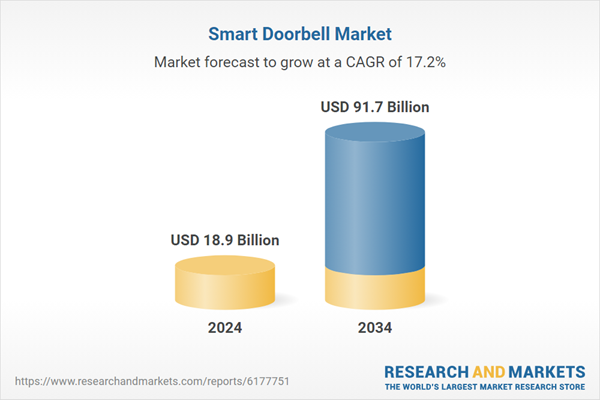This growth is fueled by increasing consumer concerns around home security and theft prevention. Many households, especially in urban and suburban regions, are turning to smart doorbells not only for monitoring entry points but also for gaining peace of mind. These devices serve as visible deterrents to intruders, reinforcing both personal safety and property protection. As smart home ecosystems evolve, integration across platforms becomes essential. Consumers now expect their smart doorbells to function effortlessly with connected devices like lights, locks, and alarms. Rapid urbanization, particularly in multi-unit residential developments, is further boosting adoption as property managers seek scalable solutions to handle visitor access and deliveries. While features like AI motion detection and facial recognition are in demand, basic video doorbells remain popular in price-sensitive regions, prompting manufacturers to diversify product tiers and price points to cater to both premium and value-driven segments.
In 2024, the wireless smart doorbells segment generated USD 5.3 billion. Their user-friendly design and easy installation process make them appealing to both homeowners and renters. The ability to set up these systems without rewiring or professional help contributes to their widespread use, especially in retrofit applications. Wireless models are compatible with existing Wi-Fi networks and typically offer quick pairing with smartphones, further boosting adoption in both established and emerging economies. Growing awareness about package theft, visitor verification, and front-door surveillance continues to drive consumer preference toward wireless models, particularly in dense urban settings where flexibility and speed of installation are essential.
The camera component segment reached USD 5.3 billion in 2024. Advancements in image quality, from HD to 2K and even 4K resolution, have raised user expectations. Features such as improved night vision, wide-angle views, HDR clarity, and reduced blind spots are shaping purchase decisions. As consumers increasingly rely on remote monitoring through mobile apps, high-performance cameras have become central to the value proposition of smart doorbells. The growing role of visual verification in home security continues to cement the camera as the most crucial part of smart doorbell systems.
North America Smart Doorbell Market held 28.2% share in 2024, growing at a robust CAGR of 17.5%. This region benefits from early adoption of smart home technologies and a high level of consumer readiness for connected devices. The availability of compatible platforms and strong e-commerce infrastructure fuels growth as consumers prioritize doorstep security amid rising concerns over theft. High disposable income and awareness of IoT technologies further support market expansion in this region, making North America one of the top-performing regions globally for smart doorbell adoption.
Key players shaping the Global Smart Doorbell Industry include Eufy Security (Anker Innovations), Vivint Smart Home, Inc., Panasonic Corporation, SkyBell Technologies, Inc., Logitech (Logi Circle), Robin Telecom Development, Netatmo (part of Legrand), Honeywell International Inc., August Home (part of ASSA ABLOY), Reolink, Remo+ (Olive & Dove), Zumimall, Wyze Labs, Inc., Ecobee, Zmodo, VTech Communications, Inc., Arlo Technologies, Inc., Google (Nest), dbell Inc., Bosch Security Systems, Owlet Home LLC, and Amazon (Ring). Leading companies in the smart doorbell industry are focusing on ecosystem integration by ensuring seamless compatibility with major smart home platforms. Many are investing in advanced AI capabilities, including facial recognition and behavioral analytics, to differentiate their offerings. Others are expanding into emerging markets with budget-friendly models that maintain core functionality while reducing costs. Strategic partnerships with e-commerce platforms, telecom providers, and home security services are being formed to expand reach and distribution.
Comprehensive Market Analysis and Forecast
- Industry trends, key growth drivers, challenges, future opportunities, and regulatory landscape
- Competitive landscape with Porter’s Five Forces and PESTEL analysis
- Market size, segmentation, and regional forecasts
- In-depth company profiles, business strategies, financial insights, and SWOT analysis
This product will be delivered within 2-4 business days.
Table of Contents
Companies Mentioned
The companies profiled in this Smart Doorbell market report include:- Amazon (Ring)
- Arlo Technologies, Inc.
- August Home
- Bosch Security Systems
- Dbell Inc.
- Ecobee
- Eufy Security
- Google (Nest)
- Honeywell International Inc.
- Logitech
- Netatmo
- Owlet Home LLC
- Panasonic Corporation
- Remo+ (Olive & Dove)
- Reolink
- Robin Telecom Development
- SkyBell Technologies, Inc.
- VTech Communications, Inc.
- Vivint Smart Home, Inc.
- Wyze Labs, Inc.
- Zmodo
- Zumimall
Table Information
| Report Attribute | Details |
|---|---|
| No. of Pages | 180 |
| Published | September 2025 |
| Forecast Period | 2024 - 2034 |
| Estimated Market Value ( USD | $ 18.9 Billion |
| Forecasted Market Value ( USD | $ 91.7 Billion |
| Compound Annual Growth Rate | 17.2% |
| Regions Covered | Global |
| No. of Companies Mentioned | 23 |









